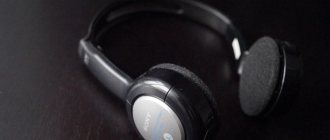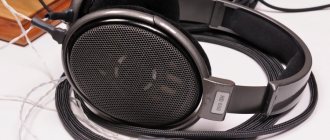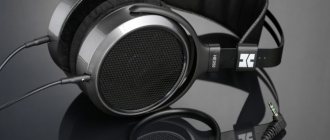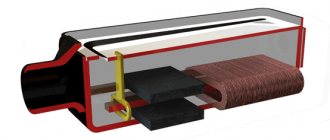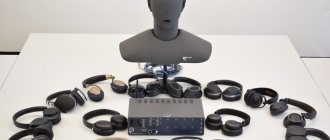How to choose the right headphones according to their parameters and what important characteristics to focus on so that the purchased device meets all your desires? After all, this accessory for listening to music differs in configuration, size, appearance and purpose.
The list of main requirements for headphones: sound quality and volume, noise insulation, sensitivity, power and design that suits the structure of the ear. In addition, the weight of the device and the presence of additional functions (for example, a built-in microphone) are important to buyers. The most important points are always indicated by the manufacturer on the packaging; all you have to do is learn to read them. This article will help you understand in detail the main 7 characteristics of headphones and tell you what parameters and how to choose this accessory.
Sensitivity
Directly related to the volume of music in the accessory. The parameter depends on the size of the magnetic core used in the headphone design and varies between 20 and 130 dB.
What does headphone sensitivity mean in dB? On the packaging it is defined as “dB/mW” or “dB/V” and shows the proportion between the volume level and power or voltage. Adjusting the sound on a portable device is a way to change its voltage. This suggests that the same headphones will sound differently at different MP3 player volumes. In addition, the number of decibels determines the energy efficiency of the headphones: the higher the sensitivity, the more economical the device’s battery consumption.
When deciding which sensitivity is better, you need to vote in favor of a device where its value will be at least 100 dB; with lower values, the sound will be very quiet, especially if you listen to music on the street. It is important to remember that prolonged listening to sounds louder than 80 dB can lead to fatigue and problems with the hearing organs.
How to choose headphones based on sensitivity? Today there are no strict standards by which manufacturers measure this parameter. Some take measurements at a frequency of 1 kHz, others reduce the indicators to 500 Hz, and still others generally take average results. The main thing that the average buyer should remember is: the higher the sensitivity level, the louder the accessory. This is provided that all other indicators are equal.
Headphone sensitivity
In the technical specifications, we can observe such a parameter as headphone sensitivity , which should give us information about how loud the headphones will play. However, in reality it often turns out that headphones with a lower number play louder than headphones with a higher number. Why is that?
First, let's figure out how the final sound pressure is determined and how it is calculated from the specified sensitivity of the headphones.
The final sound pressure level is indicated in dB SPL
. When we connect headphones to an amplifier, the amplifier delivers a certain current and output voltage level, the product of which equals power. The higher the power level we apply to the headphones, the louder they will produce sound. As we increase power, we increase both the output voltage and the current. In this case, the current strength depends on the voltage and load size, and all these parameters are completely interrelated.
If you look closely at the number indicating sensitivity, we will see that the number has two different units of measurement, for example 114 dB/mW
or 120
dB
/V. In the first case we see sensitivity expressed to power, and in the second case - to voltage. Which sensitivity is “correct”? And how do they relate to each other? Power sensitivity makes it clear how high the power consumption of the headphones is, but does not provide a comparative characteristic with other headphones, because this value greatly depends on the resistance of the headphones, and the resistance of headphones is different. Let's consider the simplest possible option. We have an amplifier whose output impedance is zero over the entire frequency range. We connect different headphones to the amplifier, of which we know their sensitivity. Our task is to identify those headphone models that will be the loudest. We will have two groups of headphones, for one we will be given sensitivity values in relation to power, and for the other - for voltage. The first group is tension sensitivity
| Name | A1 | B1 | IN 1 | G1 | D1 |
| dB/V sensitivity | 130 | 125 | 120 | 120 | 135 |
| Resistance | 16 | 60 | 70 | 15 | 12 |
The second group is sensitivity to power
| Name | A2 | B2 | AT 2 | G2 | D 2 |
| Sensitivity to dB/mW | 114 | 114 | 116 | 118 | 111 |
| Resistance | 16 | 24 | 32 | 300 | 5 |
The task comes down to fairly simple formulas and a diagram.
This circuit is a basic circuit from school physics lessons, where we have a voltage source (our amplifier) and a load (our headphones). We turned on the amplifier and adjusted the volume by turning the volume control. We took a voltmeter and measured the voltage at the output. Let's say we got 0.33 V. In order to calculate the sound pressure level of a headphone, we must use the formula: SPL = SPL(dB/V) + 20Log10(U), where
SPL(dB/V) – sensitivity of headphones expressed in terms of voltage U – voltage at the amplifier output Substituting the data for headphones A1 from the first table, we get:
130+20Log10(0.33) = 130 – 9.7 dB = 122 dB SPL.
We do the calculations for the remaining headphones of the first group. Additionally, we will calculate how much power is supplied by the amplifier to the headphones in this case.
Power calculation is calculated using the formula:
W=U*U/R, where
U – amplifier output voltage R – headphone resistance For headphones A1 we get:
0.33*0.33/16=0.0068 W = 6.8 mW
| Name | A1 | B1 | IN 1 | G1 | D1 |
| dB/V sensitivity | 130 | 125 | 120 | 120 | 135 |
| Resistance | 16 | 60 | 70 | 15 | 12 |
| SPL | 120,3 | 115,3 | 110,3 | 110,3 | 125,3 |
| Power | 6,8 | 1,8 | 1,55 | 7,26 | 7,26 |
Please note that for all headphones the differences from the sensitivity parameter are exactly the same at 9.7 dB. And the loudest ones turned out to be D1, and the quietest ones were V1 and G1. The distribution of loudness is exactly the same as that of sensitivity expressed to voltage.
At the same time, the resistance of the headphones in this case does not affect the volume. At the same time, although B1 and G1 have the same sensitivity and the same output volume, more power is supplied to G1 from the amplifier, because power depends on the resistance of the headphones, while the voltage level does not depend on the resistance. This in turn means that when listening to V1 and G1 at equal volumes, the battery of the player with G1 will run out earlier. You can also immediately note the dependence where a double change in voltage will equal 6 dB. Accordingly, if we change the output voltage multiple times, we will get the following dependence (using A1 as an example)
| Output voltage | 0,25 (1/(2*2)) | 0,5 (1/2) | 1 | 2 (1*2) | 4 (1*2*2) | 8 (1*2*2*2) |
| Outlet pressure level | 118 (130-6-6) | 124 (130-6) | 130 | 136 (130+6) | 142 (130+6+6) | 148 (130+6+6+6) |
As you can see, the calculation is very simple. And you can see that if we turn the volume knob so that the output is exactly 1 V, then the output of the headphones will be the value of their sensitivity.
Now let's count the second group. You can calculate it in different ways. You can convert the sensitivity value from power to voltage and make the calculation using a well-known formula.
Formula for converting sensitivity from power to voltage:
SPL(dB/V)=SPL(dB/mW)+20Log10(1/(0.001R)^0.5), where
SPL(dB/mW) – headphone sensitivity expressed in terms of power, R – headphone resistance The final formula for sound pressure for headphones:
SPL=SPL(dB/mW)++20Log10(1/(0.001R)^0.5)+ 20Log10(U), where
SPL (dB/mW) – headphone sensitivity expressed in terms of power, R – headphone resistance, U – amplifier output voltage. Sound pressure for A2 headphones will be:
114 - 20Log10(1/(0.001*16)^0.5)+ 20Log10(0.33) = 114+17.95-9.7 = 122.3 dB
Or you can first calculate the power level at the output of the amplifier and use another formula, through changes in the power ratio. Power formula:
W=U*U/R, where
U is the voltage at the output of the amplifier, R is the resistance of the headphones. The power for headphones A2 is obtained:
W=0.33*0.33/16 = 8.32 mW
Formula for calculating SPL when using power values:
SPL= SPL(dB/mW)+10Log10(W), where
SPL (dB/mW) - sensitivity of headphones expressed in terms of power W - power supplied to headphones Sound pressure for headphones A2 will be:
SPL=114+10Log10(8.32)=114 +8.3=122.3 dB
As you can see, in both cases the formula is either more cumbersome or requires two calculations instead of one.
Let's fill out the table.
| Name | A2 | B2 | AT 2 | G2 | D 2 |
| Sensitivity to dB/mW | 114 | 114 | 116 | 118 | 111 |
| Resistance | 16 | 24 | 32 | 300 | 5 |
| SPL | 122,3 | 120,5 | 121,3 | 113,5 | 124,3 |
| Power | 6,8 | 4,5 | 3,4 | 0,3 | 21,7 |
What can be seen from the table? Sensitivities A2 and B2, which are equal in numerical value, are not at all the same in volume. Moreover, the numerical sensitivity value is the highest for G2, but they are the quietest, while the D2 has the lowest sensitivity number and, on the contrary, they are the loudest! At the same time, the sensitivity value of B2 is higher than that of B2 and the volume distribution is approximately the same, B2 is louder than B2.
As a result, it turns out that if we do not make a detailed calculation, then we cannot at all focus on sensitivity, expressed in terms of power, as a parameter indicating the comparative volume of headphones among themselves.
Why do we often see sensitivity indicated specifically to power, and not to voltage? The fact is that the parameter indicating sensitivity to power largely shows the efficiency (efficiency) of the headphones, and here we can see that with equal sensitivity to voltage, we will get higher efficiency for headphones with high impedance. However, since the efficiency among headphones in their class is approximately at the same level, we observe an inverse relationship; with equal efficiency of headphones, headphones with low impedance will have a higher sensitivity to voltage.
For example, you can look at the Beyerdynamic DT 770 versions of 32 and 600 Ohms with the same sensitivity of 96 dB/mW, which indicates their same efficiency, but when connected to an amplifier, the 32 Ohm version will be louder than the 600 Ohm version, which is quieter at the same position of the volume knob. (32 Ohms will have a sensitivity of 111 dB/V and 600 Ohms will have a sensitivity of 98 dB/V, that’s a difference of 13 dB).
If we turn the volume level higher for the 600 Ohm version and equalize the power levels, then the headphones will play at the same volume. However, an amplifier is usually limited in terms of power level by either voltage or current. In the case of the 32-ohm version, in order for the amplifier to provide 1 mW, it is necessary to output only 0.17 V and 0.03 mA. And for 600 Ohm, 0.7 V and 0.0017 mA. It is clearly seen that low-impedance headphones require more current and less voltage, and high-impedance headphones, on the contrary, require more voltage and less current.
Often, when it comes to the fact that high-impedance headphones need a more powerful amplifier, we are not talking about whether the amplifier should actually produce more power, we are talking about the fact that the amplifier can produce just a higher voltage. However, when the consumer is poorly versed in technical nuances, the necessary idea is sometimes conveyed in the most understandable, albeit illiterate, way.
Since the amplifier’s volume knob sets the output voltage, it is more logical and practical to focus primarily on the voltage sensitivity values, especially when it comes to portable equipment.
Is there a simple relationship to convert sensitivity from power to voltage?
Yes, I have. When the resistance doubles, the sensitivity changes by 3dB.
That is, if we have headphones with a sensitivity of 114 dB/mW for 16 Ohms, then the same voltage sensitivity will be for headphones of 117 dB/mW for 32 Ohms, and 120 dB/mW for 64 Ohms.
| Sensitivity to 1 mW | 100 dB/1mW at 32 ohms = 115 dB/V | ||||||
| Resistance | 4 (16/(2*2*2)) | 8 (16/(2*2)) | 16 (16/2) | 32 | 64 (32*2) | 128 (32*2*2) | 256 (32*2*2*2) |
| Sensitivity to 1 mW | 91 (100-3-3-3) | 94 (100-3-3) | 97 (100-3) | 100 | 103 (100+3) | 106 (100+3+3) | 109 (100+3+3+3) |
Returning to Beyerdynamic, let's recalculate their difference in volume based on the same sensitivity to power at 32 and 600 Ohms.
The ratio between the resistances can be represented as 32*2*2*2*2*1.17 = 600, where we see 4 full twos, respectively, the difference between the sensitivity will be between 3*4=12 dB and 3*5=15 dB.
Converting sensitivity from dB/mW to dB/V by eye is also not a problem, because their difference is 20Log10(1/(0.001R)^0.5).
From here we get that for headphones at 4 ohms, the difference will be 24 dB, and then, when the resistance doubles, the difference will decrease by 3 dB. You only need to remember one pair of numbers as a guide, 30 dB to 1 Ohm, 0 dB to 1024 Ohm, or 15 dB to 32 Ohm, or whatever.
| Headphone resistance, Ohm | 1 | 2 | 4 | 8 | 16 | 32 | 64 | 128 | 256 | 512 | 1024 | 2048 | 4096 |
| Difference in dB between power and voltage sensitivity | 30 | 27 | 24 | 21 | 18 | 15 | 12 | 9 | 6 | 3 | 0 | -3 | -6 |
Accordingly, if we have a sensitivity of 96 dB/mW at 32 Ohms, then it will be 96+15=111 dB/V, where 15 dB is the desired difference in the table for a resistance of 32 Ohms.
I would like to hope that this material will now allow us to better navigate the technical data related to the sensitivity of headphones.
At the same time, this material did not examine various nuances, such as the dependence of sensitivity on frequency or range, counting and measurement methods, which affects the accuracy of interpretation. We'll look at this next time. Continuation of the series of materials about headphone sensitivity and other parameters
Author:
04.05.2012
Found a typo in the text?
Select and press
Ctrl+Enter
. This does not require registration. Thank you.
Share on social networks
Resistance
How to choose the right headphones based on resistance (number of ohms)? Taking this criterion into account, all devices are divided into 2 types: low-resistance and high-resistance, while this gradation is different in large and small accessories. For “kids”, all accessories up to 32 Ohms are considered low-impedance, and those with a larger number are considered high-impedance. For large specimens - up to 100 Ohms and more than 100 Ohms, respectively.
The numbers in this parameter indicate the following:
- the lower the resistance, the higher the volume of the accessory, and vice versa;
- the higher the resistance value, the more economically the battery charge is consumed;
- The lower this parameter, the greater the acoustic potential the headphones have.
Of course, you shouldn’t rely only on this data, because they are directly related to other device parameters.
How to choose the resistance of headphones (impedance) when purchasing? If an accessory is purchased for a smartphone or other gadget, you must choose options with low numbers (16-40 Ohms). For a computer or TV, the ideal solution would be values in the range of 50-150 Ohms, which guarantees 100% purity of music and speech.
To clearly demonstrate the choice taking into account resistance and sensitivity, it would be correct to make a comparative table of 3 types of headphones. For example, the “budget” Philips SHE3595BK/00, the SONY MDR-XB450 AP device from the mid-price segment and the expensive ONKYO W800BTB/00 Mic accessory.
| Model | Sensitivity, dB | Resistance, Ohm | Frequency range, Hz |
| Philips SHE3595BK/00 | 102 | 16 | 10-23500 |
| SONY MDR-XB450 AP | 102 | 24 | 5-22000 |
| ONKYO W800BTB/00 | 107 | 16 | 6-22000 |
Interesting article on the topic: New Philips products for sports and active
Impedance matters for music from tablets and smartphones
This indicator means nothing more than the amount of electrical resistance of the headphones. It is usually recommended to pay attention to resistance for those who are going to use headphones with “low-power” sound sources - portable players, laptops, tablets, smartphones, as well as computer sound cards.
It is believed that with a sufficient level of sensitivity of the headphones (we will discuss what sensitivity is considered “sufficient” later), the optimal value of their resistance for portable players, smartphones, and tablets is no more than 50-70 Ohms, and for laptops and computer sound cards – no more than 100 Ohms (numbers, of course, are approximate and averaged). At the same time, it is not recommended to use headphones whose impedance is lower than the output impedance of the source (this applies to any, not just the “low-power” devices described above) - at a minimum, this is fraught with losses in sound quality, and at maximum, damage to the source. The latter, however, is only possible in extremely advanced cases.
It would seem that everything is simple - we look at the resistance and decide whether the headphones are suitable for our source or not. In reality, things are somewhat more complicated.
Headphone drivers actually have two similar characteristics: resistance to direct current and impedance (complex resistance), which reflects the resistance of the headphones to alternating current. Since the sound signal coming from the player to the headphones is just alternating current, of these two characteristics we are interested in impedance.
Isodynamic headphones have linear impedance - their resistance does not depend on the frequency of the alternating current. But for dynamic and reinforced headphones, the impedance depending on the frequency of the current supplied to them (and, accordingly, on the purity of the sound they reproduce) can be different.
Moreover, while some headphones have an insignificant impedance spread in frequency, for others it reaches serious values - and this can have certain consequences for the sound quality. If in any part of the frequency range the impedance of the headphones is too low (lower than the output impedance of the source), then in this area there will be a loss of resolution and an increase in the level of distortion. The situation is similar when a “low-power” source cannot cope with the too high impedance of the headphones.
A small example - many owners of the popular Koss Porta Pro portable headphones, who use them with players, note among their shortcomings a slow, “indistinct”, although powerful bass. Yes, these headphones are not record holders in terms of speed and bass intelligibility, but probably if their owners tried to connect them to a sufficiently powerful amplifier, they would notice a significant improvement in this parameter. But the thing is that although the stated resistance of the Koss Porta Pro is only 60 Ohms, which is quite normal for portable headphones, in the mid-bass area it increases to 140 Ohms - and most portable players give in.
Now the question is - why do most headphones indicate impedance with only one number, and what is the use of this number? Answer: this figure, in most cases, reflects the impedance value at around 1000 Hz - it is believed that it is by this purity that the user determines and sets the volume that is comfortable for himself. The meaning of this figure is as follows: for most headphones, the “spread” of impedance depending on frequency is still not very large, and therefore this figure can serve as some kind of guideline when choosing headphones.
Headphone manufacturers rarely advertise full impedance graphs, but if you want to know everything about the impedance of a particular headphone model, you can most likely find the necessary information on the Internet.
frequency range
On the headphone box, as a rule, the standard frequency is indicated: 20 Hz-20 kHz. These parameters determine whether the user can hear a sound of a certain frequency through the accessory. So what is the value of the property and how to choose headphones based on the frequency range?
Schematically, the proportion between loudness and frequency is drawn by a graph called amplitude-frequency response (AFC). A perfectly straight line on it means the same sound. By indicating frequency numbers, the manufacturer essentially describes the length of this straight line. But the specific requirements for the characteristics are not specified in any standard.
What does the buyer need to remember and what frequency should the headphones be? Here are 3 main rules:
- You should not choose an accessory based only on frequency parameters. These numbers will only help filter out the most inappropriate options.
- When purchasing, you must take into account that the specified range is still within the range of 20 Hz-20000 Hz.
- To determine the sound character of headphones, it is better to test their capabilities live.
You should be especially careful when purchasing copies whose frequency range is very different from the standard one. Many people know that humans cannot hear high notes with a frequency of more than 25 kHz (but dolphins will), which means that this characteristic is most likely just a marketing ploy.
Frequency response curve
This is the same amplitude-frequency characteristic that was already mentioned above. It depicts the tonal balance of sounds, breaking them down into different frequencies.
To understand the issue in more detail, you need to look at the figure on the left. The graph shows the frequencies and meaning of each range. Vertical - volume level. Its value is measured in decibels; doubling the sound is equal to 6 dB on the graph.
A perfectly clear sound, without hissing or hoarseness, occurs with a line that is as close as possible to a flat line. Manufacturers make such measurements based on the SPL (sound pressure) level, and you can view the measurement results on the official websites of the brand. To navigate the schedule, it is worth considering several examples at once.
Graph on the left. Shown here are the frequency response curves for large headphones like the SONY MDR-ZX330BT.
You can read about other brand headphones in the article: New SONY MDR-EX150, MDR-EX150AP and MDR-ZX660AP headphones: bright design, powerful sound
The lines in the figure mean:
- Green is a subjective frequency response, from which measurements are based.
- Yellow is an accessory preferred by lovers of live music. In recordings of such sounds, as a rule, there are no sharp frequency fluctuations.
- Blue - professional headphones for singers and musicians, in which the emphasis is on the high frequencies. In such a device, vocals can be heard especially clearly.
- Orange - headphones in which sibilants (vowel whistling sounds) are muffled.
Next up is the picture on the right. It shows the frequency variations for in-ear headphones or earbuds (such as the Philips SHB5250BK/00). What does it show?
The green curve has the same purpose as in the previous graph. And then:
- Orange line - illustrates equipment with high output at lower frequencies. This is a good option for smartphones and other devices.
- The blue line, on the contrary, shows the headphones where the high frequencies are especially prominent. Such equipment is intended for musicians, since the voice here is heard more clearly than the music.
To focus on such indicators, you must first decide on the purpose of purchasing headphones. It is also worth considering that the price depends on the quality of the equipment.
What is sensitivity in headphones
Sensitivity shows the dependence of the speaker volume on the level of the signal supplied to it. It is measured in decibels (dB), fluctuates in the range of 90-120 dB and is determined by the dimensions of the magnetic core (coil). For miniature devices it is small, so you shouldn’t expect high volume from vacuum headphones. In them, the volume level is achieved due to the close location of the membrane to the eardrum. Full-size devices are equipped with an enlarged core, which is why they have increased power and sensitivity.
The characteristic is given in terms of power (and not voltage, which would be correct and practical) and depends on two parameters: the supplied current and voltage, which is convenient for engineering calculations, but not for the end user. And that's why. There are two impedance standards for speakers: 4 and 8 ohms, and the value is indicated next to the sensitivity. For headphones, there are dozens of common impedance values: 4, 8, 24, 32, 64... Therefore, comparing a pair of devices from different manufacturers and even lines is impractical, you won’t get a clear picture.
Manufacturers do not always provide complete information about the device. Yes, and measuring sensitivity is extremely difficult. According to the standard, it refers to the sound pressure value that headphones produce when a voltage of 1 V is applied to them.
Driver Diaphragm Diameter
This indicator in headphones directly affects the sound quality. It is logical that the larger the speaker, the louder and clearer the sound, especially the “low bass”.
If you choose small “droplets” or other headphones of a similar design, then the membrane dimensions will range from 9 to 12 mm, which clearly does not guarantee the reproduction of high-quality lows.
The “strongest” headphones in this regard are full-size ones. The diameter of their speakers is often more than 30 mm. It is with this membrane size that you can achieve ideal depth, clarity and richness of sound. And why all? The larger the membrane, the easier it is to improve it. Manufacturers install various “chips”, improved magnets, etc. inside the body of such headphones, which ultimately help develop “deep” sound.
It will be interesting to know: TOP 10 best full-size closed headphones
Headphone power
The volume of the sound will depend on this indicator, but the choice here is rather based on the technology to which they are connected. When paying attention to this parameter, it is worth considering several points:
- what this characteristic defines;
- what is measured and what power is better to choose headphones.
So, the accessory has two powers: the maximum input power, which indicates that this device can be connected to equipment with the same performance, and the nominal one. It, on the contrary, indicates the size of the signal that the headphones need to reach their peak performance.
The power that the headphones are designed for varies from 1 mW to 5000 mW. If the main goal is to purchase an accessory for a smartphone or tablet, then you should not focus on power. It is enough to take into account the sensitivity parameters so that the music plays loudly without overloading the battery.
Harmonic Distortion Factor
This property tells about the purity and clarity of the sound in the headphones. Measured as a percentage. For a good device, the coefficient does not exceed 0.5%; equipment with the highest indicators is already classified as mediocre.
While focusing on these parameters, it is also worth considering the frequency range at which the measurements were made. Thus, for low-frequency sounds the distortion rate reaches 10%, for high-frequency sounds (from 100 Hz) - 1% or less. Having read this characteristic on the packaging, you can only roughly judge the sound quality, but to be sure of this parameter, you need to listen to the headphones.
In addition, poor-quality (dull) sound in the device may occur during operation or due to breakdown. Why do headphones distort the sound? In most cases this happens due to:
- Bad wire contacts - this problem occurs in the headphone jack, which is the weakest part of the design. Especially if you regularly use the accessory during sports activities and trips, putting the player (or other device) in your pocket. Thus, a large level of load falls on the jack and the wires inside it, causing the wire to fray. The solution to the problem is to replace the jack or buy new headphones.
- Broken wire inside the device - a “afterlife” voice from the headphones can also appear if the wire is broken, which leads to the speaker. It is difficult to notice this defect, since the headphone cable is thin. Even after feeling its entire length, you may not understand where the gap is. When repairing, it is necessary to replace the entire cable.
- Water getting into the earphone - when walking with the accessory in the rain or snow, you need to be prepared for moisture getting into the inside of the device. If the headphones are not dried immediately, the water will oxidize the “insides”. You can dry the headphones near the battery (placing them on top is not recommended) or by leaving them in a jar with rice for a couple of hours, which will draw out the moisture.
- Damage to the jack for connecting equipment - another reason for distortion and poor sound in headphones can be an unsuitable jack or damaged contacts in it. The latter occurs if you often pull the jack back and forth from the socket. In case of such a breakdown, you need to contact a service center for help.
It is worth correcting these problems if they appeared on headphones that were already in use. When a dull sound, distortion or “trumpet” effect occurs with a new device, it is definitely not worth purchasing such an accessory.
Which frequency is better, and how can you find it on your headphones?
Typically, the technical characteristics of acoustic equipment are indicated on the back of the package. As a rule, it is indicated:
- frequency range (lower and upper limit);
- sound power in decibels;
- speaker distortion coefficient as a percentage (the lower the indicator, the higher the quality of the device).
To play music well, you need good headphones. The question is how to choose them?
What the frequency should be depends on the purpose of the device. Ideally, the model supports three types of frequencies with an error of 1% ranging from 100 Hz to 20,000 Hz. For the “lower frequencies” an error of up to 10% is permissible, the bass will be within the limits of standard perception. The optimal value of frequency characteristics for smartphones and phones is from 10 Hz to 20 kHz. Sensitivity is up to 100 dB, this is a kind of device efficiency. It should be taken into account that too much sound power will quickly discharge the mobile device.
For their work, professionals choose acoustic equipment with frequency characteristics from 5 Hz to 60 kHz. Practice shows that the higher the upper limit, the smoother the frequency response in the perceived interval. Although a smooth frequency response graph does not guarantee high-quality sound, the absence of dips indicates a balanced sound.
Summarizing all the information, it is easy to determine three rules for choosing headphones:
- frequency is not the main selection criterion; you need to focus on other sound indicators;
- The minimum frequency range must be at least perceptually within the range of 20 Hz to 20 kHz.
- It is better to determine the sound quality in test mode, I focus on my own ear.


